In this guide, you will learn the basics of troubleshooting portable washing machines and how to narrow down the issue? so you can apply a proper fix…
Portable washing machines are clever appliances designed for people living in teeny, tiny homes.
Whether you’re squeezed into a city center apartment or sharing space with housemates in the suburbs, these compact machines make laundry days a breeze.
Portable washing machines can be lifted, moved, and used in any room with a power socket.
The common misconception about portable washers is, they must be very different to regular washing machines.
This can discourage people from using them as they assume basic maintenance and repairs will be far too difficult.
The truth is portable washing machines are largely made up of the same bits and pieces as full-scale appliances and, when they break down, the solutions are surprisingly simple.
This article discusses some common issues with portable washing machines and how to troubleshoot them.
Types of Portable Washing Machine
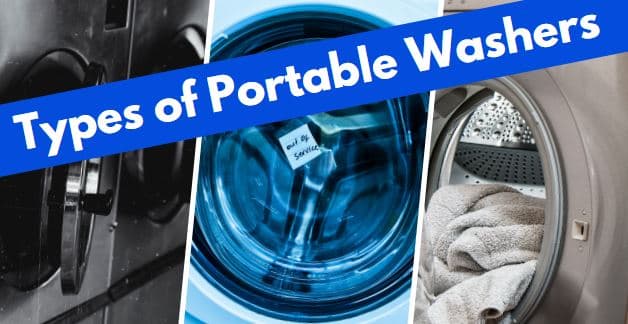
The main difference between a portable washing machine and a standard washing machine is how the water gets inside the appliance.
There is no permanent plumbing requirement because portables are made to be moved in and out of storage.
Instead of being permanently connected to the main water supply, they come with a faucet adaptor that fits any sink and fills the drum manually each time.
This eliminates many of the issues relating to filling and draining.
Blockages and leaks are easier to diagnose and repair on a portable machine because the components involved are pretty much detachable with most brands.
For example, The faucet adaptor can be removed and inspected for faults in a matter of seconds without causing any problems for the rest of the appliance.
There are two types of portable washing machines, though one is more common than the other these days.
READ: Is it Necessary to have a washing machine stand?
Top Loading Washing Machines
Top loading washing machines (portable and standard) are a rarity now because modern households prefer economical, energy-saving front load appliances.
These portable washing machines are loaded via a horizontal panel on their top where the clothes are dropped down into the appliance.
The laundry is performed by a central agitator or a pulsator on newer washing machines.
Front Loading Washing Machines
Front-loading portables are the contemporary version of a washing machine, and the type of appliance most of us are very familiar with.
They are loaded via a vertically hinged door that opens the machine’s front side.
Front-load portables are the best option because they are energy and water efficient, fast-acting, and capable of washing more clothes per cycle than top-loading appliances.
There is no central agitator in a front loading washing machine.
Alright!
Enough of Info, let’s move on to the troubleshooting part.
READ: Top Load VS Front Load Detergents
Troubleshooting Advice for Your Portable Washing Machine
In this section, we discuss solutions for common washing machine problems so you can get back to having happy laundry days again.
Topics Covered
- Portable Washing Machine Not Turning On
- How to Approach Rinsing Issues?
- Portable Washing Machine Leaks
- Filling Problems/Not Getting Enough Water
- Vibration Issues with Portable Washer
- My Portable Washer is Noisy
- Washing Machine Does Not Spin As It Should
- Washing Machine Does Not Complete the Cycle
- How to Approach Draining Issues?
- Detergent Dispensing Issues
- My Portable Washer Smells
- Conclusion
Portable Washing Machine Not Turning On
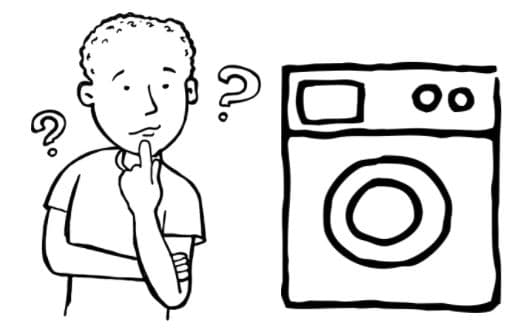
1 – Check the Socket
When your portable washing machine is completely unresponsive, the first step – even if it seems silly – is to check the plug socket.
The plug may have come loose and cut off the electricity supply.
Make sure it’s plugged in firmly and there are no visible problems such as sparks or exposed wiring.
If it still doesn’t work, plug in another appliance to determine if the issue is with the fuse or circuit breaker.
To diagnose even further, you can try to plug your portable washer to another working socket and see if that helps.
For safety, always keep the socket turned off while plugging and unplugging.
2 – Check the Power Cord
Inspect the machine’s power cord for faults.
If there are any exposed wires or heavily frayed areas, you may need to replace it.
Only somebody with electrical skills should attempt to manipulate the wiring as it can be dangerous.
3 – Check the Door/Lid Switch
Wherever your door is positioned – front or top – open it and look for the mechanism that enables it to open and close.
On front-loading machines, it’s tucked inside the door’s frame.
Press on it a few times to check if there are any problems with the catch and release mechanism.
If the mechanism doesn’t function, the machine won’t start even if there are no other faults.
It tells the washing machine when a seal has been achieved and the drum can be safely filled with water, so it must work.
Less commonly, there are issues with a washing machine’s interlock.
This is the electrical component that pairs with the latch and ensures the door stays sealed for the duration of a cycle.
This is a very tricky problem to diagnose because you can’t see it.
If all other possible faults have been eliminated, this might be the culprit.
Having said that a lot of time, the solution that you are searching for may be well documented in user instruction manuals.
So don’t forget to refer to the user instruction manual provided by your portable washing machine manufacturer.
While the machine not turning on is a common question, we also receive questions related to rinsing issues.
Let’s see how we can approach the rinsing issues with your mini washers.
How to Approach Rinsing Issues?
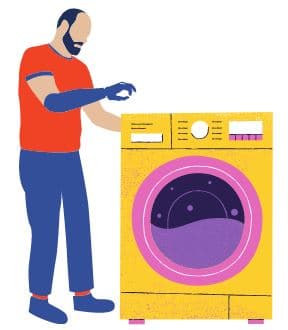
1 – Operational Error
The most common reason for improperly rinsed clothes is overloading.
If you stuff too many items inside the drum, the water can become obstructed and blocked from reaching every surface.
This is when you start to get uneven cycles that don’t clean all of the clothes in the same way.
Some may come out soapy and improperly rinsed.
If you think you’ve overloaded your portable machine, remove half the load and try the rinse cycle again.
2 – Malfunctioning Pump
Another potential cause of poor rinsing is a clogged pump.
If the machine’s drain pump is blocked with lint or debris, it may perform erratically.
Find the drain pump by opening the machine’s back panel. If the appliance is dry and unplugged, tipping it onto its front will make access easier.
The drain pump is positioned towards the bottom of the machine and fed by two large hoses.
First, check these hoses aren’t kinked or twisted.
To remove the pump, loosen the bolt that keeps the drive belt tight.
Inspect it for clogs and clear away debris if you can.
Sometimes, socks get sucked into the drain pump and cause havoc for washing machines.
If there is damage to the drain pump, it will need to be replaced.
3 – Broken Switch Assembly
Issues with a portable washing machine’s switch assembly are difficult to diagnose without advice from an electrician.
If the rinse cycle repeatedly fails, the switch assembly may be malfunctioning and preventing the transition from wash to rinse.
READ: What is RPM in Washing Machine?
Portable Washing Machine Leaks
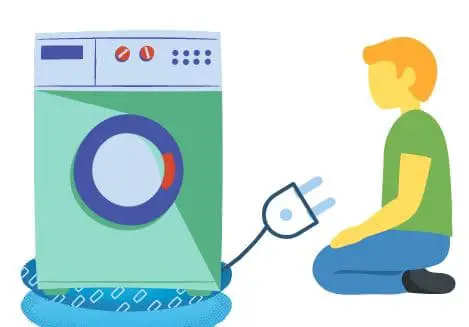
1 – Check the Faucet Adaptor
With portable washing machines, leaks are almost always an issue with the faucet adaptor.
Check the adaptor to make sure there’s a very tight seal on both ends.
The adaptor should fit snug over the faucet.
Inspect it for tears and other signs of damage.
If your appliance leaks during the fill cycle, it is almost certainly due to a loose connection.
2 – Make Sure the Surface is Level
As portable machines are designed to be moved around, they are more susceptible to their environment than standard appliances.
Make sure, wherever you use the portable washing machine, it is always on a level surface.
Tilting can cause leaks as the machine’s internal washers are sensitive by design.
They are made to lie flat and even.
You can use detachable washer legs if your floor isn’t level enough for the washing machine.
3 – Use Less Detergent
Sometimes, adding too much detergent causes excess suds and they get pushed out of the machine and onto the floor.
This is not a leak, per se, and doesn’t necessarily indicate a malfunction but it can lead to one of the errors being repeated.
READ: How to Use a Portable Washing Machine Effectively?
Filling Problems/Not Getting Enough Water
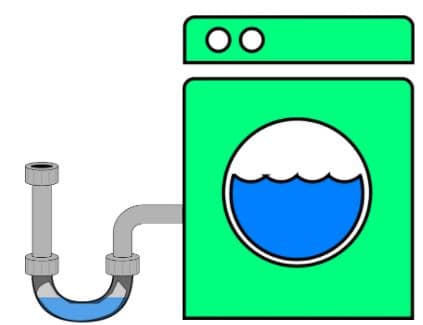
1 – Check the Faucet Adaptor
It’s easy to check the water input pipe on a portable washing machine because it is fully detachable and must be manually attached to the sink each time.
Make a regular habit to check the adaptor and pipe.
Give it a quick inspection just before you affix it to the faucet for a new cycle.
If the hose is kinked, torn or damaged in any way, the washing machine might fail to fill with water or only partially fill.
Check the inside for obstructions.
Make sure the adaptor is tight around the faucet and not leaking water.
2 – Check the Mesh Filters
Another common reason for filling failures is a clogged or obstructed filter.
When the hose is disconnected from the back of the machine, you should be able to see the filters sitting just inside the water inlet valve.
If they look grimy, remove, clean, and replace them.
3 – Check the Water Level Switch
If your portable washing machine won’t fill correctly, the issue might lie with its water level switch.
Testing for faults in this particular component requires a reasonable knowledge of electrical systems.
If you’re not confident using a volt-ohm meter, ask a professional for help.
Before doing anything else, completely unplug the washing machine to eliminate the risk of electric shocks when you touch the switch.
- Then, carefully unscrew and remove the control panel.
- The water level switch has a clear tube running into it.
- By using a volt-ohm meter, you can check if the terminals are still functional.
- Have the meter set to RX1.
- Check the three terminals by testing all possible pairings with the probe.
- One pair should give a ‘zero’ reading and all the other readings should be ‘infinity.’
If this is not the case, the water level switch is faulty.
4 – Check for Slow Flow
If you’ve eliminated all other possible faults, and the water continues to fill slowly, the issue might be with your home’s plumbing.
Unfortunately, this isn’t something that can be easily rectified, and making changes to your washing machine won’t help.
Let’s move on to the next most common issue with mini washers.
READ: Portable Washers: How They Work & their working principles
Vibration Issues with Portable Washer
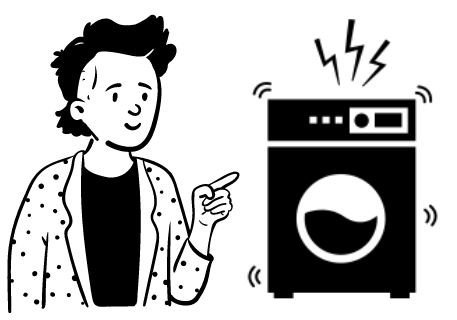
1 – Check the Surface is Level
Often, there’s a simple explanation for a washing machine that judders, shakes and vibrates erratically.
It’s probably in an unsuitable environment.
Washing machines, by their very nature, are noisy and it will cause a racket if placed against another hard surface.
The first thing to do is check that the floor underneath the portable washing machine is reasonably level and even.
If it’s overly tilted, it will shake and vibrate loudly during the spin cycles.
You can purchase detachable feet for homes that have uneven floors.
In some cases, it’s loose floorboards rattling underneath the machine that causes the noise rather than the appliance itself.
2 – Wash Lighter Loads
Overfilling a washing machine can cause a whole litany of problems including aggressive juddering and shaking.
It normally occurs because the load inside the drum is uneven and heavier on one side than the other.
To avoid excessive vibrating, be sensible when filling the machine and don’t put all the heaviest items on one side.
3 – Remove the Transportation Bolts
This really only applies to new Portable washing machines or washers that have been transported by professional movers.
During transportation, special bolts are used to stop the drum from spinning.
If you forget to remove them before use, there will be a lot of clanking, vibrating, and possibly even some damage depending on how long they remain there.
Now that you know some key things to look at, if your portable washer judders and shakes too much, let’s take a quick look at troubleshooting noise issues.
READ: How to Hook Up a Portable Washing Machine?
My Portable Washer is Noisy
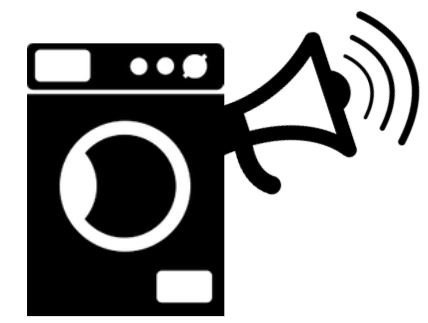
1 – Check the Surface is Level
The most common explanations for excessive noise from a portable washing machine are environmental.
These issues are easy to fix as they usually relate to an uneven surface or proximity to another hard, rigid object.
For instance, loose floorboards underneath a washing machine can rattle as the appliance vibrates and may make it sound like a lot of noise is being produced.
If this is the case, the problem isn’t really with the washing machine.
Try moving it to a more suitable surface or position it on top of a sheet of wood or hard plastic.
As a general rule of thumb, if your portable washer makes a lot of noise, try to place your washer somewhere else and see if you notice any noise.
If the problem is not solved, move to the next step.
2 – Check the Proximity of Other Objects
Alternatively, your washing machine might be rattling against other hard objects.
Washing machines will clank and become very noisy if they are positioned close (but not completely flush) with other surfaces.
This is seen a lot in standard-size ‘worktop’ appliances that sit underneath kitchen counters.
Check to see if your washing machine is rattling against a wall or any other surface before investigating the appliance’s inner components.
3 – Check the Bearings
As washing machines age, the bearings wear and eventually degrade.
Worn bearings are sometimes responsible for an inner drum banging around and making unusual noises.
Check whether this is the case by inspecting the machine’s interior.
The inner drum should move just a small distance away from the outer drum, just enough to accommodate spinning and agitation but not so much that the two drums feel like they’re coming apart.
If it’s more than a millimeter or two, the noise is probably being caused by degraded bearings.
It’s worth checking the inside of the drum carefully to see if there are any bra wires lodged inside its fill holes.
Having said that, a lot of users also complain stating their mini washing machine doesn’t spin as it used to before.
If you are also facing something similar, here are the things you should look at.
READ: 6 Things you must know about washing machine bearings
Washing Machine Does Not Spin As It Should
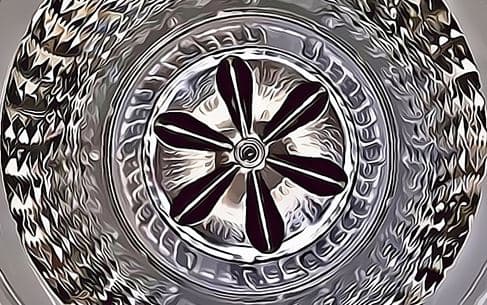
1 – Wash Lighter Loads
Certain types of Portable Washing machines have a sensor that tells the appliance how much power is required to spin the current load.
As the weight of each washing load varies, these washers must have the capacity to adjust their settings and spin with the right amount of force.
Overloading a washing machine can easily trip this sensor and cause the appliance to shut down or fail to spin correctly.
If you think this might be the case, remove some heavier clothes and allow time for the appliance to reset.
Then, try the cycle again with a lighter load.
2 – Check the Condition of the Door
If the door or any of its components are degraded, the portable washing machine will not function properly.
Spin cycles can only start after the appliance’s computer knows the door is sealed and watertight.
If it doesn’t get this signal, it may not start a cycle or it might begin to wash your clothes but stop short of spinning.
You can check the condition of the door very easily.
Just give the inside frame a visual inspection.
Look for tears in the rubber where water could leak out.
Press down on the catch and release mechanism that holds the door shut when the washing machine is in use.
If it doesn’t spring back, it may be broken.
3 – Check the Drainage
If the washing machine is failing to spin because it’s still filled with water, there’s probably a blockage somewhere.
It’s an easy problem to fix with a portable appliance because you can simply detach the drainage tube and manually remove any obstructions.
Don’t forget, with a portable washing machine, the drainage tube must be left to empty water directly into the sink or bath.
You need to put the tube in the right place because there is no integrated drainage system.
If draining is not successful, look for a problem with this tube.
Straighten it out as much as possible; kinks and bends obstruct the water as it moves from machine to sink.
Make sure there are no obstructions inside the drainage tube.
Sometimes, small items of clothing like loose socks and underwear can slip inside and cause blockages.
If this doesn’t solve the problem, check for issues in your property’s drainage.
Is your sink filling too fast for the water to drain out of the machine efficiently?
If your home’s drains are old or in poor condition, your options may be limited.
You could try draining into a bigger receptacle like the bath instead of a sink.
READ: 14 things you shouldn’t wash in a washer
Washing Machine Does Not Complete the Cycle
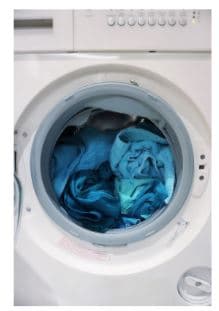
1 – Check the Door Switch
Washing machines, portable or otherwise, are designed with failsafe to prevent them from operating until fully sealed and watertight.
This is why you can’t open a washing machine immediately after a cycle.
Certain actions must be performed before you try to access your clothes and potentially let water out onto the floor.
The door switch is a simple mechanism.
However, if it is not fully activated, the washing machine will fail to start or only complete part of its cycle.
The internal timer that controls the various phases of a wash must wait for a ‘door closed’ signal before starting its program.
The door release mechanism should click and spring back effortlessly when pushed down with a finger.
There should be no holes or tears around the door which might break the seal and cause the portable washing machine to shut down for safety reasons.
2 – Test the Timer Motor
This is a tricky thing to do if you haven’t got a multimeter or volt-ohm meter, or you don’t know how to use one.
You may need to ask an electrician for help or seek advice from the manufacturer.
If you have a multimeter and some familiarity with electrics, you can test the functionality of a portable washing machine’s timer.
- First, unplug the appliance for safety reasons.
- Use the appliance’s wiring schematic to locate the terminals that regulate the timer motor.
- Use your multimeter to test for electrical continuity.
- If there is no continuity or the power is inconsistent, you may need a replacement timer.
3 – Check the Water Level Control
Your Portable washer’s timer gets a signal to confirm if it’s safe to start filling the drum with water.
It then receives another signal when the water level is sufficient and the spinning can begin.
Any problems or delays when receiving these signals will lead to a disordered cycle and your clothes may not be washed correctly.
If your washing machine is filling up with water but struggling to spin, the signal may be obstructed.
One way to test for this is to allow the machine’s drum to fill completely.
When it’s almost full, start listening for the click-clunk of the water inlet valve sealing.
This means the drum is ready for spinning and the timer should get a ‘go’ signal from the water level control.
As soon as you hear this, unplug the washing machine.
- Open up the control console on the front.
- Remove the correct wires and use a multimeter to check the terminals of the water level switch for electrical continuity.
If you’re not sure which components are which, consult the manufacturer’s handbook.
4 – Check the Timer Knob
As the washing machine’s timer regulates a cycle, the dial or knob section of the timer turns along with the timer’s shaft.
If the plastic dial is degraded or broken in any way, it may turn slowly or fail to rotate with the timer shaft as each part of the cycle transitions into the next leading to a disordered wash and/or skipped steps.
You can replace a broken timer dial but it requires a little precision.
- First, push the timer dial in and unthread it from the skirt and any other components.
- Turn counterclockwise to free it.
- If there’s a plastic cap in the middle, remove it.
- This should expose the fastener that is securing the dial.
- Undo the fastener and, if this doesn’t release the dial, look for a retaining shaft positioned just behind it.
Note: Not all washing machine models have this shaft.
READ: Can vinegar damage the washing machine?
Twin tub washing machine spinner not working
When facing spinner issues, consider potential culprits such as overloading, damaged belts, motor damage, clogged drainage, and faulty lid switches.
Overloading the machine, exceeding its specified capacity, can strain the motor, hindering effective spinning.
Washers drive belt play a crucial role in spinner functionality, and if worn-out, they lead to a loss of spin efficiency.
Similarly, motor damage, often caused by overuse or short circuits, significantly impacts the spinner’s functionality, affecting both the washer and chime.
Also, a blocked drainage system disrupts smooth spinner functioning, causing ineffective spinning.
Lastly, a faulty lid switch, serving as a safety device, can prevent the machine from spinning.
Promptly addressing these issues ensures optimal twin tub washing machine performance.
How to Approach Draining Issues?
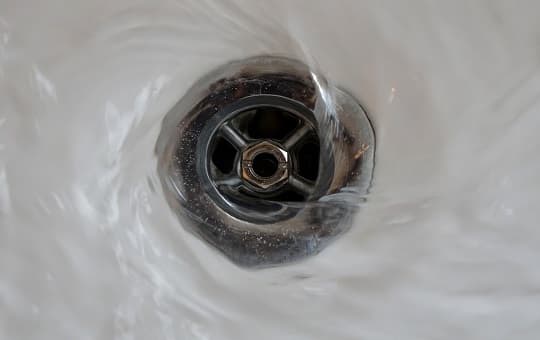
1 – Listen for the Drainage Pump
Drainage issues in Portable washers are almost always caused by an obstruction that’s stopping the water from moving or a faulty pump.
One way to check if the pump is operating without dismantling the appliance is to listen for it.
Wait until close to the end of the wash when the water should be emptying out.
If you can hear the pump turn on and attempt to drain the drum, it’s probably not faulty and the issue is more likely a blockage.
If you can’t hear the pump at all, it may be broken and need replacing.
2 – Check the Pump for Blockages
Before you buy a new drainage pump, check your existing one for blockages.
It’s easier than you think for small objects like coins, hair clips and socks to get caught in the pump’s filter.
- Locate the pump by opening the machine’s back panel.
- Gently tipping the appliance onto its front (when dry) will help you reach it.
- Look near the bottom of the machine for a component that’s connected to two large hoses.
- To remove the drainage pump, loosen the bolt that keeps the drive belt secure and taut.
- Inspect it for blockages and remove any lint or debris that might become a clog later.
If there is damage to the drain pump, it will probably need to be replaced.
3 – Check Your Home’s Drainage
If the problem isn’t with the way your portable machine drains, it must be an issue with the drainage in your home’s sink.
You can check for blockages by unscrewing the spigot that connects the sink to the outside drain.
Place a bucket underneath before you remove the U-bend. It will let out water.
Check the removed pipe for blockages, and see if you can spot any problems with the rest of them too.
Efficient drainage depends on your machine’s pipes transferring their water to your property’s drainage system without interruption or obstruction.
This is another common issue that many faces especially when the washer is old.
READ: 20 things you must know about fabric softeners
Detergent Dispensing Issues
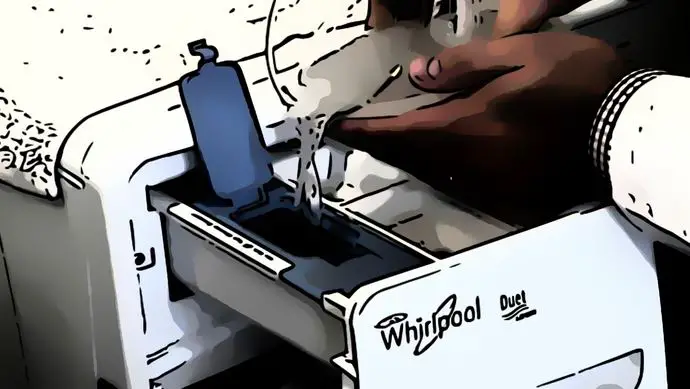
1 – Clean the Detergent Drawer
The most common reason for detergent dispensing failures is a clogged-up detergent drawer.
Over time, this component gets dirty so it needs to be cleaned regularly.
Washing powders combine with liquid cleaners to create sticky, gungy messes.
Always try cleaning the drawer first because this will probably fix your detergent dispensing issues.
Make sure the siphon holes are free of obstructions.
Clean with soap and water. Then, rinse thoroughly with plenty of cold water to remove any lingering suds.
2 – Try Using a Different Detergent
Some portable washing machines are sensitive to thicker powder detergents and clog easily if they are used.
It’s partly due to their size. It’s important to take your appliance’s compact, moveable nature into account and make smart choices about what you put in it.
If your detergent drawer clogs regularly, try a different brand of detergent.
Liquid detergents OR High-Efficiency Detergents are recommended because they leave far fewer remnants.
Having said that, you’ll still need to clean the drawer regularly.
READ: 12 answers about Laundry Pods that everyone should know
My Portable Washer Smells
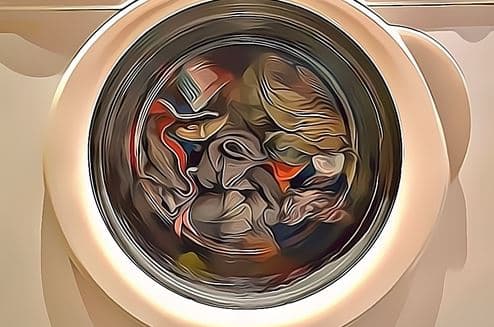
1 – Run a Service Wash
To tackle unpleasant odors, run your portable washing machine on a full cycle without any clothes inside.
This is what’s known as a ‘service’ wash.
The selected cycle must reach fairly high temperatures to kill off any odor-causing bacteria inside the drum.
No, it’s not energy efficient, but it’s just a one-off clean.
According to many washing machine manufacturers, it’s good to complete a hot service wash once per month.
It helps to minimize bacteria levels in the washing machine.
2 – Clean the Door Seal
Mould and bacteria love to accumulate in the folds of the rubber seal around a washing machine’s door.
It’s dark, warm, and gets cleaned less regularly than other parts of the appliance.
Unpleasant smells can develop in this area and thorough, firm scrubbing is the best way to prevent them.
Black mold is nasty stuff that, given time, can eat away at the rubber seal.
In some severe cases, the seal may need to be completely replaced.
Prevention is by far the best method for avoiding problems with mold and foul smells.
Clean your portable washing machine at least twice per year, preferably more often.
3 – Clean the Detergent Drawer
The detergent drawer is another place where mold can fester and cause nasty smells.
If lingering odors are a problem, try cleaning the drawer and removing all traces of old detergent and conditioner.
4 – Let Clean Air Circulate
Sometimes, all it takes to prevent bad smells are a little ventilation.
The next time you finish a wash, leave the washing machine door slightly opened for 20-60 minutes.
Leave the detergent drawer open to the clean, fresh air for the same amount of time.
This will help to reduce the number of bacteria in both the drawer and the drum.
READ: What is Soil Level in Washing Machine?
Seek Professional Assistance
- Complex Repairs: If the issue involves internal components, electrical circuits, or complex mechanisms, we strongly advise seeking professional help. Attempting such repairs without expertise can be dangerous and may damage the machine further.
- Risk of Property Damage: Incorrect DIY repairs may lead to water leaks, flooding, or other damages to your home. Professionals have the experience to handle repairs effectively, reducing the risk of property damage.
- Manufacturer’s Support: For warranty-covered machines, tampering with the appliance may void the warranty. For assistance, speak with the manufacturer or accredited service provider.
Potential Risks of DIY Repairs
- Electrical Accidents: Mishandling electrical components can result in severe electric shocks, leading to injuries or even fatalities.
- Water Hazards: Incorrect repairs may cause water leaks, leading to slips, falls, and property damage.
- Fire Hazards: Faulty repairs can lead to electrical fires, endangering lives and property.
- Machine Damage: Inexperienced repairs may worsen the original issue, resulting in higher repair costs or the need for a replacement.
Safety Recommendations
- Electrical Hazards: Portable washing machines involve electrical components. Before troubleshooting, ensure the machine is unplugged to avoid the risk of electric shocks or injuries.
- Use Proper Tools: Always use the right tools for the job and carefully handle them. Incorrect tools may damage the machine or pose safety risks.
- Protective Gear: When dealing with moving parts or potential hazards, wear appropriate protective gear, such as gloves and safety goggles.
- Keep Children Away: If troubleshooting in a household with children, keep them safe from the machine to avoid accidents.
- No Water Contact: Never touch the machine with wet hands or when in contact with water, as it can lead to electric shock.
Conclusion
This article has discussed many of the common problems that can affect your portable washing machine’s efficiency.
These appliances are surprisingly low maintenance and even those with little DIY experience should be able to fix issues quickly.
The only time you should exercise a lot of caution is when a repair requires you to change the existing wiring.
If you’re unsure about working with electrical components, you should consult a professional and allow them to fix the problem safely.
Otherwise, you may cause further damage to the machine or put yourself at risk of electric shocks.
Whatever component or part you’re working on, you should always unplug your portable washing machine from the socket before starting.
We hope we were able to answer your queries, if you still have further questions, there are high chances that it may have already been answered in our Portable Washing Machines FAQ Section.
Note: If you want to go for a new portable washer and want to select the best, we recommend you go through our Guide to Buy the best portable washer under budget.





